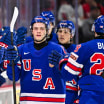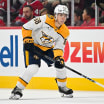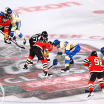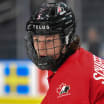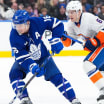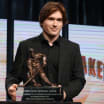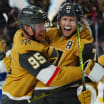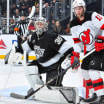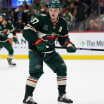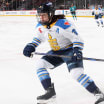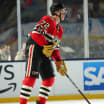The 2018 NHL Trade Deadline (3 p.m. ET; Feb. 26) is less than a week away. In his biweekly scrapbook for NHL.com, longtime hockey reporter and analyst Stan Fischler, "The Hockey Maven," takes a look at one of the wildest trades in League history:
Only a mastermind such as Toronto Maple Leafs boss Conn Smythe could be so antsy and unsatisfied, even after his team had upset the defending champion Montreal Canadiens to win the Stanley Cup in 1947.
Smythe rocked NHL with 1947 blockbuster
Maple Leafs owner's stunning acquisition of Chicago star Max Bentley helped fuel dynasty
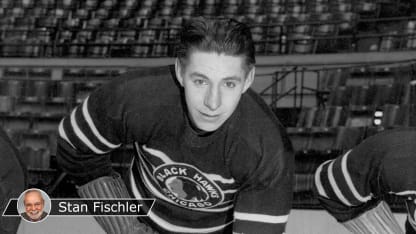
By
Stan Fischler
Special to NHL.com
It was Smythe's pervasive angst that inspired him to make what would become the mother of all hockey trades.
Who ever heard of an NHL team trading not only an entire first-rate forward line, but also two solid, experienced defensemen for one smallish center?
Let's start with the offense part of this. Only forward lines that are really effective get nicknames, and the "Flying Forts of Toronto" worked like perfectly meshed gears in lifting the Maple Leafs to their six-game victory in the 1947 Final
Not only did Gus Bodnar, Gaye Stewart and Bud Poile all hail from Fort William, Ontario, but each was a stylist in his own right.
Bodnar, the center, already held the NHL record for fastest goal from the start of a career, scoring 15 seconds into his first game on Oct. 30, 1943. Bodnar also won the 1944 Calder Trophy as the NHL's top rookie.
Stewart, who won the Calder in 1943, had starred for the legendary Maple Leafs team that was down three games to none in the 1942 Cup Final against the Detroit Red Wings but won an unprecedented four straight.
Poile, the line's primary gunner, possessed one of the hardest shots since Charlie Conacher, who supposedly had hockey's greatest howitzer. At the time, Poile was regarded as the prize of the line.
The defensemen were no slouches, either. Bob Goldham and Ernie Dickens were behind construction of the Miracle of '42. Considered the father of shot-blocking, Goldham looked to have a bright future as with the Maple Leafs. Ditto, Dickens.
Smythe, however, had other ideas.
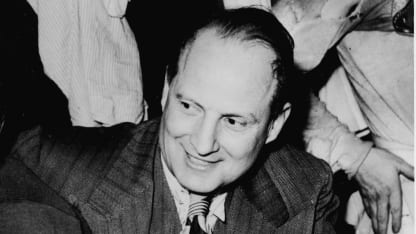
© B Bennett/Getty Images
Conn's anxiety was rooted in the fact that his captain and top center Syl Apps was threatening to retire, although the future Hall of Famer still was in the scoring prime of his career. Minus Apps, the Leafs couldn't expect to win a second straight Cup.
Maple Leafs coach Hap Day -- who had won Cups in 1942, 1945 and 1947 -- agreed. Scanning opposition lineups, Smythe extracted a few big names as possible trade targets, then narrowed it down to one.
"Smythe was smart," Day said. "When he had an idea, he checked it out with more than one person. He came to me and asked me who was the best center in the League.
"I went back in my mind; which center had caused the most trouble for us? Max Bentley. But he didn't take my word for it and checked around."
Smythe: "When I was in Chicago, I talked about Max with the waitresses in the hotel, the clerks at the desk, the taxi driver and many others, and they all said the same thing -- that (Chicago president) Bill Tobin wouldn't trade Max; he was too popular."
Maxwell Herbert Lloyd (Max) Bentley of the Chicago Black Hawks had just won two consecutive scoring titles and was a Hart Trophy winner as the NHL's most valuable player in the 1945-46 season.
His nickname was "The Dipsy Doodle Dandy From Delisle" and it was said -- very complementarily -- that he skated like a scared jackrabbit. His wrist shot, perfected by milking cows on the family farm in Saskatchewan, was regarded as the best and most accurate in the League.
There seemed no reason at all for Tobin to deal such a gem, especially since Bentley was the balance wheel of the "Pony Line" with older brother Doug on one wing and Bill Mosienko on the other.
But there was one reason for such an exchange. Tobin's teams were perennial cellar-dwellers, rarely getting even as high as fourth place in the six-team League. Yes, Tobin was looking for help, big time, but not at the expense of busting up his best line.
On Oct. 28, 1947, as trade rumors swirled on State Street in Chicago and Yonge Street in Toronto, Tobin declared: "The Bentleys are definitely not for sale."
Persistent to a fault, Smythe insisted on huddling with Tobin. "We were kidding each other," remembered Chicago's hockey boss, "and then he said he'd give me four or five players for Max. But I didn't want five guys from Tulsa, one of his farm teams."
The poker-faced Smythe then raised the ante. "I'm serious about the five for Bentley," he told Tobin, "I need a first-class center and Max would be the man."
Tobin figured that if he could obtain an experienced, well-oiled forward line and a pair of playoff-hardened defensemen, he couldn't go wrong. On Nov. 3, 1947, the deal was sealed when Tobin added minor league forward Cy Thomas as a bonus.
The Globe and Mail described it as "The greatest mass trade in hockey history."
Not surprisingly, there were repercussions. On his farm in Delisle, Saskatchewan, Bill Bentley wept because he believed that his highly skilled sons would no longer be able to make their magic together. Max put it bluntly: "It makes me feel like I lost my right arm."
By contrast, the Maple Leafs' dressing room was ecstatic. Goalie Turk Broda, who had faced Bentley's shot for many years, enthused: "With Max on our side, I ought to win the Vezina Trophy hands down."
Still, Smythe had to justify the top-heavy deal to his Maple Leaf Gardens Board of Directors, not to mention Toronto's hockey-mad fandom.
"It's a gamble," Smythe declared, "but worth it because we're getting the league scoring leader for center duties. With Apps, Bentley and (Ted) Kennedy to center our lines and Nick Metz as a utility player to spell them, we'll have strength down the middle that a championship team needs."
There was plenty of explaining to do on the Chicago side, but coach Johnny Gottselig admitted that breaking up the Bentleys was the toughest part of the deal.
"But," Gottselig noted, "we needed fresh blood and no other club wanted any of our players except Max."
The Flying Forts were initially shocked, but as a group they seconded Poile's motion when he insisted that it was for the best. "We'll get Chicago into the playoffs," Poile asserted, "or bust our gussets."
That said, the best the five players sent to Chicago could do was very little in comparison to what Bentley did for the Maple Leafs. Chicago finished last and remained a non-playoff team until the 1952-53 season, with Bodnar the only member of the trade still with the Black Hawks.
Meanwhile, Max Bentley paced the Maple Leafs to first place in the 1947-48 season and a second straight Stanley Cup. A beaming Smythe summed up his gamble of a deal after kissing the Cup.
"This," he proclaimed, "is the greatest team I ever had!"
Even after Apps made good on his promise and retired after the 1948 championship, Bentley and Kennedy spearheaded an unprecedented third straight Cup in 1949 and added a fourth in five seasons in 1951.
Arguably the happiest member of the Maple Leafs -- after helping defeat Montreal in the five-game 1951 Final -- was Bentley who orchestrated the tying goal in the final minute of the third period.
"It was my biggest thrill," he said. "The fans hollered so much I think the noise lasted 15 minutes. And then we won in overtime."

